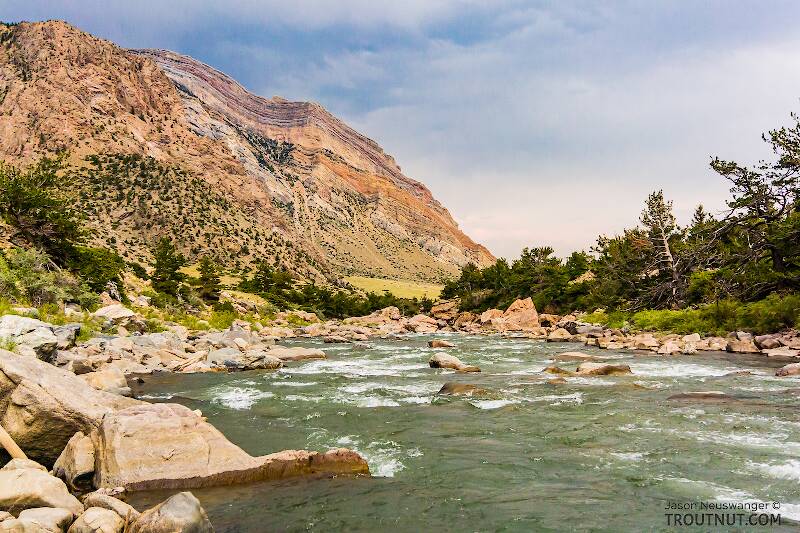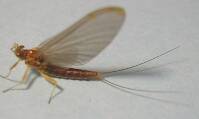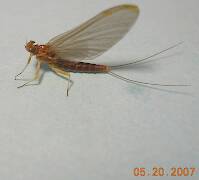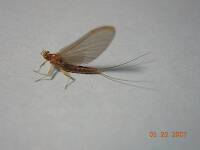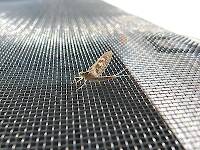
Hex Mayflies
Hexagenia limbata
The famous nocturnal Hex hatch of the Midwest (and a few other lucky locations) stirs to the surface mythically large brown trout that only touch streamers for the rest of the year.
Featured on the forum


Troutnut is a project started in 2003 by salmonid ecologist Jason "Troutnut" Neuswanger to help anglers and
fly tyers unabashedly embrace the entomological side of the sport. Learn more about Troutnut or
support the project for an enhanced experience here.
Konchu on May 27, 2009May 27th, 2009, 11:44 pm EDT
The recent thread about the Coffin Fly made me curious about the names for naturals and their imitations. That discussion indicated that the Coffin Fly's name came from its funereal coloration, but I've also heard/read that the name came from the piles of expired spinners associated with this spooky species. (Try saying that five times fast)
Some are pretty clear, such as the white-gloved howdy, but others are not so.
What are your favorite names? Where did these originate?
Some are pretty clear, such as the white-gloved howdy, but others are not so.
What are your favorite names? Where did these originate?
Martinlf on May 28, 2009May 28th, 2009, 3:14 am EDT
The common names blue quill, red quill, black quill etc. have always seemed cool to me. I would assume the names came from early fly patterns using stripped hackle quills, but I'm open to correction.
"He spread them a yard and a half. 'And every one that got away is this big.'"
--Fred Chappell
--Fred Chappell
GONZO on May 28, 2009May 28th, 2009, 9:54 am EDT
Konchu,
Here are several (as best I can trace them), starting with the Green Drake/Coffin Fly and March Brown/Gray Fox recently under discussion:
Green Drake--borrowed from British fly-fishing tradition. The name "drake" is a reference to male waterfowl, usually the male mallard. The OED mentions usage applicable to mayflies in 1658, but the Drake Fly was one of the famous "jury of twelve" from The Treatise of Fishing with an Angle (first published in 1496, though written earlier). It is most often assumed that the application of the word "drake" to mayflies comes from the use of male mallard wing or breast feathers in the construction of imitations. However, Charles Cotton (who added the fly-fishing section to Walton's Compleat Angler) had a different take:
Coffin Fly--this seems to have been a name in local usage in the Catskills when Preston Jennings attributed the name (A Book of Trout Flies, 1935) to the coloration of the male spinners. Whatever the actual origin, Ernie Schwiebert echoed Jennings' color-based attribution in Matching the Hatch (1955).
March Brown--also borrowed from British usage, March Brown is a name for European Rhithrogena species that often emerge in March. Jennings used this name (as the American March Brown) for vicarium.
Grey Fox--the use of this name for fuscum seems directly attributable to Jennings: (Notice that Jennings did not use the Americanized spelling, which might indicate that it was an appropriation of an earlier British name.)
Quill Gordon--most fly fishers know that the Quill Gordon was tied by Theodore Gordon and is the name (almost universally) applied to Epeorus pleuralis. There has long been some question as to whether Gordon ever intended to imitate this species. If so, the argument goes, the use of wood-duck flank feathers to imitate the gray wings of pleuralis was certainly a strange choice.
Hendrickson, Red Quill--the Hendrickson (fly pattern) was named for Albert Everett Hendrickson, a contemporary of Theodore Gordon. Roy Steenrod originated this pattern on the Beaverkill (1916). Dark and Light Hendricksons followed, sometimes said to match male and female, but species like E. subvaria, invaria, and rotunda were all considered to be part of the Hendrickson hatch for quite some time. Jennings applied the name Hendrickson to invaria. As late as the publication of Nymphs (1973), Ernie Schwiebert used puzzling names like Dark Blue-Winged Hendrickson for invaria, Dark Red Quill for rotunda, and Blue-Winged Hendrickson for subvaria, clearly pointing to a longstanding confusion about these species. Red Quill is a very old (British) name, but the dry fly pattern often used to imitate male Hendrickson duns or spinners is usually attributed to Art Flick. (In keeping with the Catskill connection to many of the names/patterns associated with this hatch, some might also remember the Lady Beaverkill, a wet and then dry-fly pattern dressed with a yellow butt to imitate the egg sac of female Hendrickson spinners.)
Blue-Winged Sulphur, Pale-Winged Sulphur--our use of "sulphur" for invaria/rotunda (and perhaps dorothea) may be largely due to Vince Marinaro's A Modern Dry Fly Code (1950). Although the name might have been used locally or regionally at the time, he said this: Later in the same chapter he expressed regret about being unable to identify the species, but the Blue-Winged Sulphur that he described is clearly invaria/rotunda, and the smaller Pale-Winged Sulphur may (or may not) be dorothea.
Blue-Winged Olive--perhaps the most famous (and abused) common name borrowed from the British, American fly fishers apply this name to dozens of species in different genera (many without olive bodies or "blue" wings). Curiously, although the Brits have many common names incorporating "olive" (like Dark Olive, Large Dark Olive, Small Dark Olive, Medium Olive, Olive Upright, and Pond Olive), their Blue-Winged Olive name seems to be applied most often to a single species, the legendary Serratella (Ephemerella) ignita.
Cahill, Light Cahill--these names are broadly applied to several species in Maccaffertium, Stenacron, and Stenonema. The original Cahill was tied by Dan Cahill. The Light Cahill variation is attributed to Theodore Gordon, although the very pale dressing we see most often was created by William Chandler.
Leadwing Coachman, White-Gloved Howdy--two names used for Isonychia. The first came from the dark-winged version of the Coachman wet fly, a traditional favorite that worked especially well in streams with good Isonychia populations. The second is a personal favorite that is both descriptive and whimsical. It was used by Charles Wetzel for a fly pattern he designed to imitate the female spinners. Even if it did not originate with him (I'm uncertain about that), the name likely would have been lost to time without the popularization attributable to Wetzel.
Canadian Soldier (or Canadian Sailor), Michigan Caddis--these are two of a multitude of common names sometimes applied to Hexagenia species. The first was mildly derogatory, implying that the massive Hex hatches on the Great Lakes appeared to be invading from the Canadian side. The Canadians retaliated with names like Ohio Volunteer and other, less complimentary names (American Bums). The infamous Michigan Caddis name derives from a large dry fly (the Michigan Night Caddis) designed by Art Winnie and often used to imitate Hexagenia mayflies. Although Winnie is now remembered as someone who didn't know his insect orders, some have pointed out that the fly also imitated large Ptilostomis caddisflies that emerge at night in June and July. Poor Art Winnie may have been slandered by success.
Here are several (as best I can trace them), starting with the Green Drake/Coffin Fly and March Brown/Gray Fox recently under discussion:
Green Drake--borrowed from British fly-fishing tradition. The name "drake" is a reference to male waterfowl, usually the male mallard. The OED mentions usage applicable to mayflies in 1658, but the Drake Fly was one of the famous "jury of twelve" from The Treatise of Fishing with an Angle (first published in 1496, though written earlier). It is most often assumed that the application of the word "drake" to mayflies comes from the use of male mallard wing or breast feathers in the construction of imitations. However, Charles Cotton (who added the fly-fishing section to Walton's Compleat Angler) had a different take:
...and his tail turns up towards his back, like a mallard, from whence, questionless, he has his name of the Green-drake.
Coffin Fly--this seems to have been a name in local usage in the Catskills when Preston Jennings attributed the name (A Book of Trout Flies, 1935) to the coloration of the male spinners. Whatever the actual origin, Ernie Schwiebert echoed Jennings' color-based attribution in Matching the Hatch (1955).
March Brown--also borrowed from British usage, March Brown is a name for European Rhithrogena species that often emerge in March. Jennings used this name (as the American March Brown) for vicarium.
Grey Fox--the use of this name for fuscum seems directly attributable to Jennings:
The natural fly is well represented by an artificial fly which the writer designed some years ago, and which for want of a better name has been called the Grey Fox.
Quill Gordon--most fly fishers know that the Quill Gordon was tied by Theodore Gordon and is the name (almost universally) applied to Epeorus pleuralis. There has long been some question as to whether Gordon ever intended to imitate this species. If so, the argument goes, the use of wood-duck flank feathers to imitate the gray wings of pleuralis was certainly a strange choice.
Hendrickson, Red Quill--the Hendrickson (fly pattern) was named for Albert Everett Hendrickson, a contemporary of Theodore Gordon. Roy Steenrod originated this pattern on the Beaverkill (1916). Dark and Light Hendricksons followed, sometimes said to match male and female, but species like E. subvaria, invaria, and rotunda were all considered to be part of the Hendrickson hatch for quite some time. Jennings applied the name Hendrickson to invaria. As late as the publication of Nymphs (1973), Ernie Schwiebert used puzzling names like Dark Blue-Winged Hendrickson for invaria, Dark Red Quill for rotunda, and Blue-Winged Hendrickson for subvaria, clearly pointing to a longstanding confusion about these species. Red Quill is a very old (British) name, but the dry fly pattern often used to imitate male Hendrickson duns or spinners is usually attributed to Art Flick. (In keeping with the Catskill connection to many of the names/patterns associated with this hatch, some might also remember the Lady Beaverkill, a wet and then dry-fly pattern dressed with a yellow butt to imitate the egg sac of female Hendrickson spinners.)
Blue-Winged Sulphur, Pale-Winged Sulphur--our use of "sulphur" for invaria/rotunda (and perhaps dorothea) may be largely due to Vince Marinaro's A Modern Dry Fly Code (1950). Although the name might have been used locally or regionally at the time, he said this:
Throughout this discussion I have used the terms "sulphur" or "blue-winged sulphur" to describe these particular mayflies. These terms actually describe the color of the bodies which are a sulphury yellow color in various shades of light and dark. All of them belong to the great genus Ephemerella, and they are close kinsmen to the Hendrickson.
Blue-Winged Olive--perhaps the most famous (and abused) common name borrowed from the British, American fly fishers apply this name to dozens of species in different genera (many without olive bodies or "blue" wings). Curiously, although the Brits have many common names incorporating "olive" (like Dark Olive, Large Dark Olive, Small Dark Olive, Medium Olive, Olive Upright, and Pond Olive), their Blue-Winged Olive name seems to be applied most often to a single species, the legendary Serratella (Ephemerella) ignita.
Cahill, Light Cahill--these names are broadly applied to several species in Maccaffertium, Stenacron, and Stenonema. The original Cahill was tied by Dan Cahill. The Light Cahill variation is attributed to Theodore Gordon, although the very pale dressing we see most often was created by William Chandler.
Leadwing Coachman, White-Gloved Howdy--two names used for Isonychia. The first came from the dark-winged version of the Coachman wet fly, a traditional favorite that worked especially well in streams with good Isonychia populations. The second is a personal favorite that is both descriptive and whimsical. It was used by Charles Wetzel for a fly pattern he designed to imitate the female spinners. Even if it did not originate with him (I'm uncertain about that), the name likely would have been lost to time without the popularization attributable to Wetzel.
Canadian Soldier (or Canadian Sailor), Michigan Caddis--these are two of a multitude of common names sometimes applied to Hexagenia species. The first was mildly derogatory, implying that the massive Hex hatches on the Great Lakes appeared to be invading from the Canadian side. The Canadians retaliated with names like Ohio Volunteer and other, less complimentary names (American Bums). The infamous Michigan Caddis name derives from a large dry fly (the Michigan Night Caddis) designed by Art Winnie and often used to imitate Hexagenia mayflies. Although Winnie is now remembered as someone who didn't know his insect orders, some have pointed out that the fly also imitated large Ptilostomis caddisflies that emerge at night in June and July. Poor Art Winnie may have been slandered by success.
Quick Reply
Related Discussions
Topic
Replies
Last Reply
1
Apr 18, 2007
by Troutnut
by Troutnut
9
Apr 29, 2009
by Taxon
by Taxon

